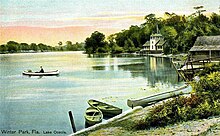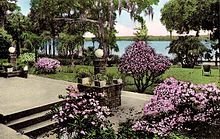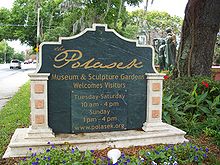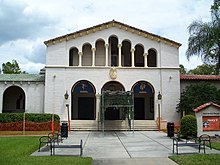Winter Park, Florida
Winter Park | |
|---|---|
| City of Winter Park | |
| Motto(s): "City of culture and heritage" | |
 Location in Orange County and the state of Florida | |
| Country | United States |
| State | Florida |
| County | Orange |
| Established | 1882 |
| Chartered | 1887 |
| Government | |
| • Mayor | Kenneth W. Bradley |
| Area | |
| • Total | 10.2 sq mi (26 km2) |
| • Land | 8.7 sq mi (23 km2) |
| • Water | 1.5 sq mi (4 km2) |
| Elevation | 92 ft (28 m) |
| Population (2011)Template:GR | |
| • Total | 28,398 |
| • Density | 3,208.4/sq mi (1,238.8/km2) |
| Time zone | UTC-5 (Eastern (EST)) |
| • Summer (DST) | UTC-4 (EDT) |
| ZIP code(s) | 32789, 32792 |
| Area code | 407 |
| FIPS code | 12-78300Template:GR |
| GNIS feature ID | 0293428Template:GR |
| Website | www |
Winter Park is a suburban city in Orange County, Florida, United States. The population was 27,852 at the 2010 census.[1] It is part of the Orlando–Kissimmee Metropolitan Statistical Area. The city is home to Rollins College, Full Sail University and the Charles Hosmer Morse Museum of American Art, which houses the largest collection of Tiffany glass. Winter Park features open park space, residential areas, and a street-side shopping district along Park Avenue.
Winter Park was founded as a resort community mainly by northern business magnates in the late 19th and early 20th centuries. It is recognized as the first centrally planned community in Florida;[citation needed] its main street includes civic buildings, retail, art galleries, a private liberal arts college, museums, a park, a train station, a golf course country club, a historic cemetery, and a beach and boat launch. Winter Park also holds the Mead Botanical Garden which is a 47.6 acre park that encompasses several ecosystems. Among its amenities is an amphitheater, Discovery Barn and a recreation center. Many structures are more than 100 years old. The scenic Olde Winter Park area is punctuated by small, winding brick streets, and a canopy of old southern live oak and camphor trees, draped with Spanish moss. The city draws thousands of visitors to annual festivals including the Bach Festival, the nationally ranked Sidewalk Art Festival, and the Winter Park Concours d'Elegance.
History

The site was first inhabited by Europeans in 1858, when David Mizell Jr. bought an 8-acre (32,000 m2) homestead between Lakes Virginia, Mizell, and Berry. A settlement, called Lake View by the inhabitants, grew up around Mizell's plot. It got a post office and a new name—Osceola—in 1870.
The area did not develop rapidly until 1880, when a South Florida Railroad track connecting Orlando and Sanford was laid a few miles west of Osceola. Shortly afterwards, Loring Chase came to Orange County from Chicago to recuperate from a lung disease. In his travels, he discovered the pretty group of lakes just east of the railbed. He enlisted a wealthy New Englander, Oliver E. Chapman, and they assembled a very large tract of land, upon which they planned the town of Winter Park. Over the next four years they plotted the town, opened streets, built a town hall and a store, planted orange trees, and required all buildings to meet stylistic and architectural standards. They promoted it heavily.[2] During this time, the railroad constructed a depot (1882), connected to Osceola by a dirt road.
In 1885, a group of businessmen started the Winter Park Company and incorporated it with the Florida Legislature; Chase and Chapman sold the town to the new company. In a land bubble characteristic of Florida history, land prices soared from less than $2 per acre to over $200, with at least one sale recorded at $300 per acre.


In 1885, the Congregational Assembly of Florida started Rollins College, the state's first four-year college. The following year the Seminole Hotel on Lake Osceola opened. This was a resort complete with the luxuries of the day: gas lights, steam heating, a string orchestra, a formal dining room, a bowling alley, and long covered porches.[citation needed]
Presidential visits
The first president to visit was Chester A. Arthur, who reported that Winter Park was "the prettiest place I have seen in Florida."[3] President Grover Cleveland visited the area and was given a huge reception at the Seminole Hotel on February 23, 1888. He enjoyed the Bounding Horse Cart ride and stated that it was the most pleasant diversion of his Florida trip. The New York Times reported on his visit that "The Philadelphian and Bostonian founders had done a good job with the town."
The following four years both hotel and the town became a fashionable winter resort for northern visitors. The next president to visit the area was Franklin D. Roosevelt in March 1936. He was conferred an honorary degree in literature at Rollins College.
The Winter Park sinkhole
In May 1981, during a period of record-low water levels in Florida's limestone aquifer, a massive sinkhole opened up near the corner of Denning Drive and Fairbanks Avenue. In a single day the hole widened to 320 feet (98 m) and to a depth of 90 feet (27 m), destroying an import car dealership, a public pool, and large portions of Denning Drive. A two-story home disappeared into the sinkhole. The deepest part of the limestone cavern must have been directly under the house as not even the peak of its roof could be seen after the sinkhole stabilized. Fortunately, no one was in the house at the time the cavern roof collapsed. City engineers managed to stabilize the sinkhole, which drew national attention and became a popular tourist attraction during the summer of 1981. A carnival-like atmosphere arose around the area, with vendors selling food, balloons, and t-shirts to visitors. Eventually the novelty wore off as the city repaired the damage and turned the sinkhole into man-made Lake Rose.[4]
The Langford Resort Hotel
The Langford Hotel served as a gateway to "Old Florida" attractions in Central Florida and a community social hub for decades.
Famous guests included Dean Martin, Frank Sinatra, Ray Charles, Larry King, Hugh Hefner, John Denver, Langford winter resident Lady Bird Johnson, and President Ronald Reagan and his wife Nancy Reagan, who celebrated their 40th wedding anniversary there.[5]
The Langford was celebrated in a party in late 1999, closed, and was demolished.[6] A portion of the former Langford property (as of mid 2009) has been developed into luxury mid-rise condominiums. The remaining parcel is now vacant and is the future site of a hotel to be owned and operated by Rollins College.[7]
The Temple Grove
An orange grove, known as the Temple Grove, stood on the south side of Palmer Avenue just east of Temple Drive. The temple orange was grown on the old Wyeth grove on Palmer Avenue (later Temple Grove) owned at the time by Louis A. Hakes, whose son was the first to notify Temple of the different quality of the new orange. The orange was introduced and cataloged by Buckeye Nursery in 1917, the year W. C. Temple died. Myron E. Gillett and his son D. Collins Gillett later went on to plant the largest orange grove in the world in the 1920s (5,000 acres (2,000 ha)) in Temple Terrace, Florida.
The Winter Park Sidewalk Art Festival
The Winter Park Sidewalk Art Festival is one of the nation's oldest, largest juried outdoor art festivals, rated among the top shows by Sunshine Artist and American Style magazines.[8] In 2012, about 1,200 artists from around the world applied for entry, and an independent panel of judges selected 225 national and international artists to attend the show. The National Endowment for the Arts, the White House, Congress, and many others have lauded the Festival for promoting art and art education in Central Florida. An all-volunteer board of directors runs the annual festival, now in its 50th year.[9]
Geography

The city is northeast of and adjacent to Orlando. Elevation ranges between 66 and 97 feet (20 and 30 m) above sea level.
According to the United States Census Bureau, the city has a total area of 10.2 square miles (26.3 km2). 8.7 square miles (22.5 km2) of it is land and 1.5 square miles (3.9 km2) of it (14.62%) is water.[10] It is nestled among the Winter Park Chain of Lakes, a series of aquifer-fed lakes interconnected by a series of navigable canals, which were originally created for flood control and to run logs to a sawmill on present-day Lake Virginia. The lakes are popular for boating, watersports, fishing and swimming.
The city is traversed by the old Orlando-Oviedo ("Dinky Line") railroad bed, which until the 1960s had a stop at Lake Virginia/Rollins College at the city park now known as Dinky Dock. Much of this right of way has been converted to a rail-trail pedestrian/biking path in the form of the Cady Way Trail, which leads from Cady Way Park toward the Baldwin Park neighborhood and downtown Orlando, and in the opposite direction to Oviedo and beyond (via the Florida Trail), thanks to a new pedestrian bridge spanning Semoran Boulevard (SR 436) in Orange County.
Currently, CSX Transportation operates a rail line through Winter Park on the former Atlantic Coast Line, with an Amtrak station in downtown's historic Central Park.
Due to its close proximity to Orlando, Winter Park is a city which many commuters traverse to access downtown Orlando. These commuters come from outlying suburban areas such as Oviedo, Winter Springs, Maitland, Altamonte Springs and Casselberry. Winter Park's municipal government has combated speeding and aggressive driving in its downtown core and residential areas by lowering speed limits to 20 miles per hour (32 km/h) in some areas, adding textured traffic-calming brick roads, and aggressively enforcing the law within the city limits. These measures have contributed to some traffic congestion, but preserve the quality of life for residents and encourage pass-thru commuters to seek alternate, more appropriate high-speed routes to downtown (such as SR436/Semoran Blvd, Lake Howell Road, US17-92/Orlando Ave, Interstate 4, and the 408/East West Expressway and 417/Greeneway toll roads).[citation needed]
Climate
| Climate data for Winter Park, FL | |||||||||||||
|---|---|---|---|---|---|---|---|---|---|---|---|---|---|
| Month | Jan | Feb | Mar | Apr | May | Jun | Jul | Aug | Sep | Oct | Nov | Dec | Year |
| Mean daily maximum °F (°C) | 72 (22) |
74 (23) |
79 (26) |
83 (28) |
88 (31) |
91 (33) |
92 (33) |
92 (33) |
90 (32) |
85 (29) |
79 (26) |
73 (23) |
83.17 (28.43) |
| Mean daily minimum °F (°C) | 50 (10) |
51 (11) |
56 (13) |
60 (16) |
66 (19) |
71 (22) |
73 (23) |
73 (23) |
72 (22) |
65 (18) |
59 (15) |
53 (12) |
62.42 (16.90) |
| Average precipitation inches (mm) | 2.43 (62) |
2.35 (60) |
3.54 (90) |
2.42 (61) |
3.74 (95) |
7.35 (187) |
7.15 (182) |
6.25 (159) |
5.76 (146) |
2.73 (69) |
2.32 (59) |
2.31 (59) |
48.35 (1,228) |
| Source: The Weather Channel[11] | |||||||||||||
Demographics
| Census | Pop. | Note | %± |
|---|---|---|---|
| 1980 | 22,339 | — | |
| 1990 | 22,623 | 1.3% | |
| 2000 | 24,090 | 6.5% | |
| 2010 | 27,852 | 15.6% | |
| source: | |||
As of the censusTemplate:GR of 2000, there were 24,090 people, 10,722 households, and 5,864 families residing in the city. The population density was 3,281.6 inhabitants per square mile (1,267.2/km²). There were 11,431 housing units at an average density of 1,557.1 per square mile (601.3/km²). The racial makeup of the city was 85.90% White, 10.52% African American, 0.16% Native American, 1.32% Asian, 0.02% Pacific Islander, 0.94% from other races, and 1.14% from two or more races. Hispanic or Latino of any race were 4.31% of the population.
There were 10,722 households out of which 21.5% had children under the age of 18 living with them, 43.2% were married couples living together, 9.0% had a female householder with no husband present, and 45.3% were non-families. 38.4% of all households were made up of individuals and 18.6% had someone living alone who was 65 years of age or older. The average household size was 2.10 and the average family size was 2.80.
In the city the population was spread out with 18.5% under the age of 18, 9.7% from 18 to 24, 25.0% from 25 to 44, 23.8% from 45 to 64, and 22.9% who were 65 years of age or older. The median age was 43 years. For every 100 females there were 83.6 males. For every 100 females age 18 and over, there were 79.4 males.
The median income for a household in the city was $48,884, and the median income for a family was $73,697. Males had a median income of $50,975 versus $32,066 for females. The per capita income for the city was $38,791. About 5.0% of families and 7.8% of the population were below the poverty line, including 10.0% of those under age 18 and 6.1% of those age 65 or over.
Economy
Adventist Health System and Bonnier Corporation are based in Winter Park.
Top employers
According to the City's 2010 Comprehensive Annual Financial Report,[12] the top employers in the city are:
| # | Employer | # of Employees |
|---|---|---|
| 1 | Winter Park Memorial Hospital | 1,433 |
| 2 | Rollins College | 683 |
| 3 | Orange County Public Schools | 659 |
| 4 | City of Winter Park | 527 |
| 5 | Publix | 450 |
| 6 | Bonnier | 402 |
Notable people

- Casey Affleck, actor
- Michael Barimo, singer
- Amanda Bearse, actress
- Kevin Beary, sheriff
- Delbert Black, first Master Chief Petty Officer of the Navy[13]
- James Bonamy, country musician
- George Brett, general
- JC Crissey, film producer
- Meg Crofton, business executive
- Nick Faldo, golfer and broadcaster
- Louis Frey, Jr., congressman
- Paula Hawkins, politician
- Gina Hecht, actress
- Orel Hershiser, professional baseball player
- Davey Johnson, professional baseball player
- Arielle Kebbel, actress
- Kidd Kraddick, radio host
- Matt Kuchar, golfer
- Rashard Lewis, professional basketball player (Miami Heat)
- Spencer Locke, actress
- Patty Maloney, actress
- Michael James Nelson, writer/actor
- Summer Phoenix, actress
- Albin Polasek, sculptor/educator
- Doc Rivers, basketball coach
- Gamble Rogers, folk musician
- Annie Russell, theatrical actress
- Allen Trovillion, politician
- Fred Tyler, swimmer/coach
- Alexander Vyssotsky, astronomer
- Darius Washington, Jr., professional basketball player
- Daniel Webster (Florida politician)
- George Weigel, artist
Educational institutions

- St. Margaret Mary Catholic School
- Aloma Elementary School[14]
- Brookshire Elementary School[15]
- The Geneva School
- Glenridge Middle School
- Lakemont Elementary School[16]
- The Parke House Academy[17]
- High schools
- Colleges
- Full Sail University
- Rollins College
- Valencia Community College, Winter Park Campus
- Fortis College, Winter Park Campus
- Winter Park Tech[18]
- Other
- Crealde School of Art[19]
Sites of interest

- All Saints Episcopal Church
- Edward Hill Brewer House
- Casa Feliz Historic House Museum
- Comstock-Harris House
- Cornell Fine Arts Museum
- Fleet Peeples Park[20]
- Hannibal Square
- Kraft Azalea Park
- Mead Botanical Garden[21]
- Charles Hosmer Morse Museum of American Art
- Mount Moriah Missionary Baptist Church
- Albin Polasek Museum and Sculpture Gardens
- Winter Park Historical Museum[22]
- Winter Park Farmers' Market
- Winter Park Public Library[23]
- Winter Park Sidewalk Art Festival[24]
- Woman's Club of Winter Park
Transportation
References
- ^ "Profile of General Population and Housing Characteristics: 2010 Demographic Profile Data (DP-1): Winter Park city, Florida". U.S. Census Bureau, American Factfinder. Retrieved September 21, 2012.
- ^ Facts taken from a copy of the original Seminole Hotel promotional brochure.
- ^ "The Seminole, Winter Park, Orange County, Florida" (PDF). Retrieved 2012-01-05.
- ^ "Google Maps". Maps.google.com. January 1, 1970. Retrieved November 15, 2012.
- ^ Facts taken from original Langford Hotel property promotional material.
- ^ "Langford Hotel History". Wppl.org. Retrieved 2012-01-05.
- ^ "Rollins seeks developer, architect for proposed inn". Orlando Business Journal. February 8, 2010.
- ^ "Show Review Archives". Sunshine Magazine.
- ^ "51st Annual Winter Park Sidewalk Art Festival". WFTV.
- ^ "Geographic Identifiers: 2010 Demographic Profile Data (G001): Winter Park city, Florida". U.S. Census Bureau, American Factfinder. Retrieved September 21, 2012.
- ^ "Monthly Averages for Winter Park, FL". Weather.com. 2010. Retrieved 2010-05-16.
- ^ "City of Winter Park CAFR" (PDF). Retrieved 2012-02-24.
- ^ Michael Robert Patterson. "Del Black, Master Chief Petty Officer, United States Navy". Arlingtoncemetery.net. Retrieved 2012-01-05.
- ^ "Aloma Elementary School". Eal.ocps.net. Retrieved 2012-01-05.
- ^ "Brookshire Elementary School". Brookshire.ocps.net. Retrieved 2012-01-05.
- ^ "Lakemont Elementary School". Elk.ocps.net. Retrieved 2012-01-05.
- ^ "The Parke House Academy". The Parke House Academy. Retrieved 2012-01-05.
- ^ "Winter Park Tech". Wpt.ocps.net. 2011-04-14. Retrieved 2012-01-05.
- ^ "Crealde School of Art". Crealde.org. Retrieved 2012-01-05.
- ^ "Fleet Peeples Park". Ffpp.org. Retrieved 2012-01-05.
- ^ "Mead Garden". Mead Garden. Retrieved 2012-01-05.
- ^ "Winter Park Historical Association & Museum". Winterparkhistorical.com. Retrieved 2012-01-05.
- ^ "Winter Park Public Library". Wppl.org. 2011-12-06. Retrieved 2012-01-05.
- ^ "Winter Park Sidewalk Art Festival". Wpsaf.org. Retrieved 2012-01-05.

